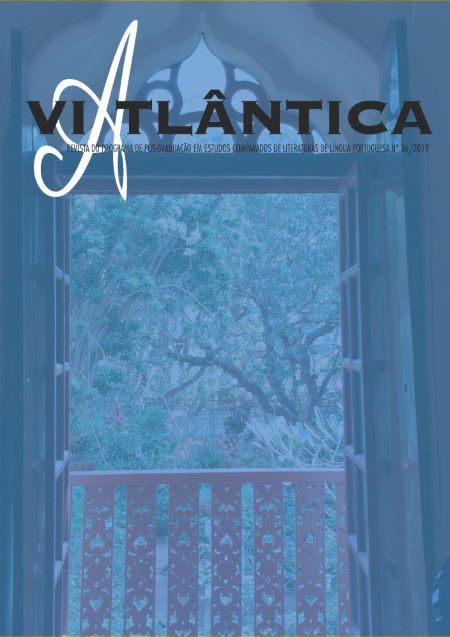RICE AS METAPHOR IN ORLANDO DA COSTA’S SIGN OF WRATH (1961)
DOI:
https://doi.org/10.11606/va.v0i36.160272Keywords:
bhatkar, mundkar, rice, social and human conflictsAbstract
The article discusses the bhatkar-mundkar relationship and how rice cultivation and production are used by Orlando da Costa in the novel The Sign of Wrath. The author describes, in the context of Goa, social conflicts as being centered on the relationship between the mundkar (rural worker) and the bhatkar (landlord). The fragility of the social situation of the mundkar, as an individual who cultivates rice on account of others and being at the same time dependent on it for its own subsistence, is the central focus of the novel. Costa’s work emphasizes the importance of rice in the Goan economy and how food can play an important role in social organization and regulation.
Downloads
References
ANÔNIMO. A Crise de subsistencias e o fomento – projectos de medidas, Santa Cruz: Tip. XriRamanatii, 1919.
Boletim Oficial de 1919. Nova Goa: Imprensa Nacional, 1919.
Techno Economic Survey of Goa, Daman and Diu. New Delhi: National Council of Applied Economic Research, 1964.
CORREIA-AFONSO, Pedro. A cor local na obra de Orlando da Costa, 1961. Disponível em: http://archiveofgoanwritinginportuguese.blogspot.in. Acesso em: 12 de março de 2016.
COSTA, Orlando da. O Signo da Ira. Lisboa: Temas da Actualidade, 1996.
DEVI, Vimala e SEABRA, Manuel de. A Literatura Indo-Portuguesa. Lisboa: Junta de Investigações do Ultramar, 1971.
DIAS, Remy. Some aspects of the consumption history of Estado da India: 1900-50. In: MALEKANDATHIL, P.; DIAS, R. (eds). Goa in the 20th Century. History and Culture. Panaji: Institute Menezes Braganza, 2008, p.72-121.
GARMES, Helder. Colonialismo e conflito cultural em O Signo da ira de Orlando da Costa. In: MACHADO, Everton; BRAGA, Duarte (Orgs.). Goa portuguesa e pós-colonial: literatura, cultura e sociedade. V. N. Famalicão: Húmus, 2012, p.95-106.
MASCARENHAS-KEYES, Stella. Colonialism, migration and the international Catholic Goan community. Saligão: Goa 1556, 2011 .
MIRANDA, Eufemiano de Jesus. Oriente e Ocidente na Literatura Goesa: Realidade, Ficção, História e Imaginação. Saligão: Goa 1556, 2012.
PEREIRA, A. de Bragança. Etnografia da India Portuguesa. New Delhi: Asian Educational Services, 1991.
PEREIRA, Rui Gomes. Goa vol.II. Gaunkari (the Old Village Association). Panaji: A. Gomes Pereira, 1981.
ROCHA, Leopoldo da. O Signo da Ira de Orlando da Costa, 1961. Disponível em: http://archiveofgoanwritinginportuguese.blogspot.in. Acesso em março de 2016.
TEIXEIRA, Rui de Azevedo. O Signo da Ira (The Sign of Anger): Ethno-literature and neo-realism in a case of literary excellence. In: BORGES, C.; PEREIRA, O.G; STUBBE, H. (eds). Goa and Portugal History and Development. New Delhi: Concept Publishing Company, 2000, p. 398-401.
Downloads
Published
Issue
Section
License
Copyright (c) 2019 Maria de Lourdes Bravo da Costa

This work is licensed under a Creative Commons Attribution-NonCommercial-NoDerivatives 4.0 International License.
Authors who publish with this journal agree to the following terms:
- Authors retain copyright and grant the journal right of first publication with the work simultaneously licensed under a Creative Commons Attribution License that allows others to share the work with an acknowledgement of the work's authorship and initial publication in this journal.
- Authors are able to enter into separate, additional contractual arrangements for the non-exclusive distribution of the journal's published version of the work (e.g., post it to an institutional repository or publish it in a book), with an acknowledgement of its initial publication in this journal.
- Authors are permitted and encouraged to post their work online (e.g., in institutional repositories or on their website) prior to and during the submission process, as it can lead to productive exchanges, as well as earlier and greater citation of published work (See The Effect of Open Access).






















